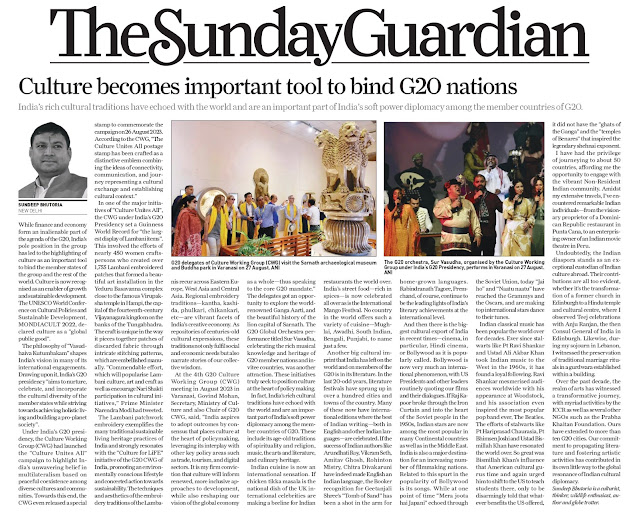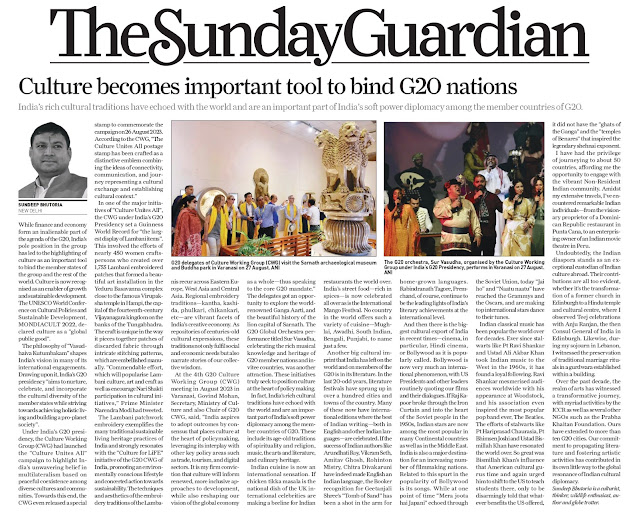Culture becomes important tool to bind G20 nations
India’s rich cultural traditions have echoed with the world and are an important part of India’s soft power diplomacy among the member countries of G20.
While finance and economy form an inalienable part of the agenda of the G20, India’s pole position in the group has led to the highlighting of culture as an important tool to bind the member states of the group and the rest of the world. Culture is now recognised as an enabler of growth and sustainable development. The UNESCO World Conference on Cultural Policies and Sustainable Development, MONDIACULT 2022, declared culture as a “global public good”.
The philosophy of “Vasudhaiva Kutumbakam” shapes India’s vision in many of its international engagements. Drawing upon it, India’s G20 presidency “aims to nurture, celebrate, and incorporate the cultural diversity of the member states while striving towards achieving holistic living and building a pro-planet society”.
Under India’s G20 presidency, the Culture Working Group (CWG) had launched the “Culture Unites All” campaign to highlight India’s unwavering belief in multilateralism based on peaceful coexistence among diverse cultures and communities. Towards this end, the CWG even released a special stamp to commemorate the campaign on 26 August 2023. According to the CWG, “The Culture Unites All postage stamp has been crafted as a distinctive emblem combining the ideas of connectivity, communication, and journey representing a cultural exchange and establishing cultural context.”
In one of the major initiatives of “Culture Unites All”, the CWG under India’s G20 Presidency set a Guinness World Record for “the largest display of Lambani items”. This involved the efforts of nearly 450 women craftspersons who created over 1,755 Lambani embroidered patches that formed a beautiful art installation in the Yeduru Basavanna complex close to the famous Virupaksha temple in Hampi, the capital of the fourteenth-century Vijayanagara kingdom on the banks of the Tungabhadra. The craft is unique in the way it pieces together patches of discarded fabric through intricate stitching patterns, which are embellished manually. “Commendable effort, which will popularise Lambani culture, art and craft as well as encourage Nari Shakti participation in cultural initiatives,” Prime Minister Narendra Modi had tweeted. The Lambani patchwork embroidery exemplifies the many traditional sustainable living heritage practices of India and strongly resonates with the “Culture for LiFE” initiative of the G20 CWG of India, promoting an environmentally conscious lifestyle and concerted action towards sustainability. The techniques and aesthetics of the embroidery traditions of the Lambanis recur across Eastern Europe, West Asia and Central Asia. Regional embroidery traditions—kantha, kashida, phulkari, chikankari, etc—are vibrant facets of India’s creative economy. As repositories of centuries-old cultural expressions, these traditions not only fulfil social and economic needs but also narrate stories of our collective wisdom.
At the 4th G20 Culture Working Group (CWG) meeting in August 2023 in Varanasi, Govind Mohan, Secretary, Ministry of Culture and also Chair of G20 CWG, said, “India aspires to adopt outcomes by consensus that places culture at the heart of policymaking, leveraging its interplay with other key policy areas such as trade, tourism, and digital sectors. It is my firm conviction that culture will inform renewed, more inclusive approaches to development, while also reshaping our vision of the global economy as a whole—thus speaking to the core G20 mandate.” The delegates got an opportunity to explore the world-renowned Ganga Aarti, and the beautiful history of the lion capital of Sarnath. The G20 Global Orchestra performance titled Sur Vasudha, celebrating the rich musical knowledge and heritage of G20 member nations and invitee countries, was another attraction. These initiatives truly seek to position culture at the heart of policy making.
In fact, India’s rich cultural traditions have echoed with the world and are an important part of India’s soft power diplomacy among the member countries of G20. These include its age-old traditions of spirituality and religion, music, the arts and literature, and culinary heritage. Indian cuisine is now an international sensation. If chicken tikka masala is the national dish of the UK international celebrities are making a beeline for Indian restaurants the world over. India’s street food—rich in spices—is now celebrated all over as is the International Mango Festival. No country in the world offers such a variety of cuisine—Mughlai, Awadhi, South Indian, Bengali, Punjabi, to name just a few.
Another big cultural imprint that India has left on the world and on members of the G20 is in its literature. In the last 20-odd years, literature festivals have sprung up in over a hundred cities and towns of the country. Many of these now have international editions where the best of Indian writing—both in English and other Indian languages—are celebrated. If the success of Indian authors like Arundhati Roy, Vikram Seth, Amitav Ghosh, Rohinton Mistry, Chitra Divakaruni have indeed made English an Indian language, the Booker recognition for Geetanjali Shree’s “Tomb of Sand” has been a shot in the arm for home-grown languages. Rabindranath Tagore, Premchand, of course, continue to be the leading lights of India’s literary achievements at the international level.
And then there is the biggest cultural export of India in recent times—cinema, in particular, Hindi cinema, or Bollywood as it is popularly called. Bollywood is now very much an international phenomenon, with US Presidents and other leaders routinely quoting our films and their dialogues. If Raj Kapoor broke through the Iron Curtain and into the heart of the Soviet people in the 1950s, Indian stars are now among the most popular in many Continental countries as well as in the Middle East. India is also a major destination for an increasing number of filmmaking nations. Related to this spurt in the popularity of Bollywood is its songs. While at one point of time “Mera joota hai Japani” echoed through the Soviet Union, today “Jai ho” and “Naatu naatu” have reached the Grammys and the Oscars, and are making top international stars dance to their tunes.
Indian classical music has been popular the world over for decades. Ever since stalwarts like Pt Ravi Shankar and Ustad Ali Akbar Khan took Indian music to the West in the 1960s, it has found a loyal following. Ravi Shankar mesmerised audiences worldwide with his appearance at Woodstock, and his association even inspired the most popular pop band ever, The Beatles. The efforts of stalwarts like Pt Hariprasad Chaurasia, Pt Bhimsen Joshi and Ustad Bismillah Khan have resonated the world over. So great was Bismillah Khan’s influence that American cultural gurus time and again urged him to shift to the US to teach students there, only to be disarmingly told that whatever benefits the US offered, it did not have the “ghats of the Ganga” and the “temples of Benares” that inspired the legendary shehnai exponent.
I have had the privilege of journeying to about 50 countries, affording me the opportunity to engage with the vibrant Non-Resident Indian community. Amidst my extensive travels, I’ve encountered remarkable Indian individuals—from the visionary proprietor of a Dominican Republic restaurant in Punta Cana, to an enterprising owner of an Indian movie theatre in Peru. Undoubtedly, the Indian diaspora stands as an exceptional custodian of Indian culture abroad. Their contributions are all too evident, whether it’s the transformation of a former church in Edinburgh to a Hindu temple and cultural centre, where I observed Teej celebrations with Anju Ranjan, the then Consul General of India in Edinburgh. Likewise, during my sojourn in Lebanon, I witnessed the preservation of traditional marriage rituals in a gurdwara established within a building.
Over the past decade, the realm of arts has witnessed a transformative journey, with myriad activities by the ICCR as well as several other NGOs such as the Prabha Khaitan Foundation. Ours have extended to more than ten G20 cities. Our commitment to propagating literature and fostering artistic activities has contributed in its own little way to the global resonance of Indian cultural diplomacy.
This article was published in the Sunday Guardian on 03.08.2023

 October 1, 2024
October 1, 2024
